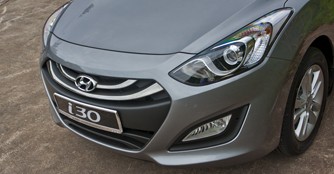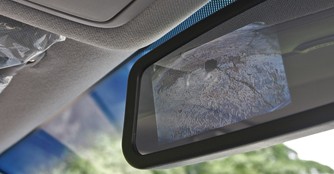Hyundai i30 1.6 (A) Review
24 Sep 2012|26,471 views
It wasn't too long ago when each of us bore a prejudiced opinion towards automotive offerings from the Korean republic (some still do). That, mainly has got to do with their low-cost approach - we reckon what's durable can't be inexpensive too.
Over the years, however, the Korean carmakers have managed to churn out a number of eye-catching variants, which in instances made their more technically-superior rivals look dull. The i30 hatch is without a doubt one of them.
The first i30 marked a major departure for Hyundai. It was a city car which brought the carmaker's fine effort to shine. Four years now, the second iteration underwent yet another major transformation, looking all set to attract the likes of continental buyers.
Exterior
The latest hatch from Hyundai looks nothing quite like the previous. Dimension wise, the new hatch has grown in almost all aspects, most notable being the increased length (55mm) and lowered stance (down by 10mm and wider by 5mm), which gives it a more athletic look. Its front fascia (which will be the forefront of future Hyundai models), similar to the marque's recently launched Elantra and Veloster, is indeed eye-catching. Fans of the i30 are bound to love the stylish look, more so for younger drivers.
Besides the overhauled facet, body panels too, promote a more dimensional look with sharper creases running down the hood and alongside the flanks. As a result, the i30 is much more evocative among its segment contenders when it comes to styling.
Over the years, however, the Korean carmakers have managed to churn out a number of eye-catching variants, which in instances made their more technically-superior rivals look dull. The i30 hatch is without a doubt one of them.
The first i30 marked a major departure for Hyundai. It was a city car which brought the carmaker's fine effort to shine. Four years now, the second iteration underwent yet another major transformation, looking all set to attract the likes of continental buyers.
Exterior
The latest hatch from Hyundai looks nothing quite like the previous. Dimension wise, the new hatch has grown in almost all aspects, most notable being the increased length (55mm) and lowered stance (down by 10mm and wider by 5mm), which gives it a more athletic look. Its front fascia (which will be the forefront of future Hyundai models), similar to the marque's recently launched Elantra and Veloster, is indeed eye-catching. Fans of the i30 are bound to love the stylish look, more so for younger drivers.
Besides the overhauled facet, body panels too, promote a more dimensional look with sharper creases running down the hood and alongside the flanks. As a result, the i30 is much more evocative among its segment contenders when it comes to styling.
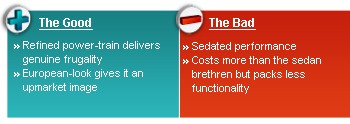 |
While the front facet adopts a sophisticated look with the help of chrome / matt trims and projector-style lamps, the rear shies from such integrations. In place is a simple looking reflector-type assembly. Albeit taking on a flowing shape from the side panels and bumper, the rear somehow feels less head-turning than the front.
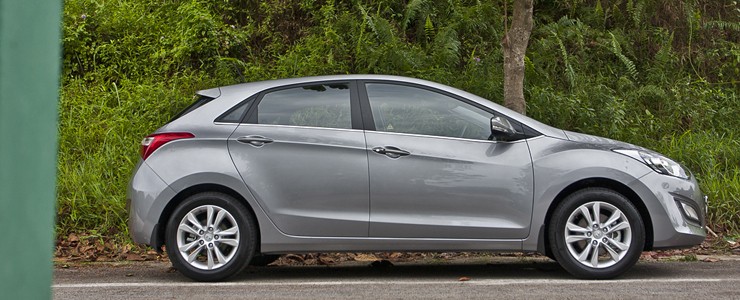 |
Interior
On the inside, the i30 feels pleasantly modern despite the simplistic design of the buttons and switches. The centre console has the main role to play in exuding a contemporary feel, thanks to the twin beams finished in an attractive aluminium-look.
Hyundai's mission to move upmarket can be seen clearly from the selection of gizmo novelties. For instance, the centre rear-view mirror doubles as a reverse camera display - a clever integration that will no doubt raise the brand's quality image.
In general, there is a nice mixture of contrasting materials, with quality plastics trims decorating the steering wheel and front console, as well as out-lining the door cards. Air-con controls come in old-fashioned styled knobs, but there are no qualms about its ease of use and effectiveness in cooling down the cabin in our tropical climate.
On the inside, the i30 feels pleasantly modern despite the simplistic design of the buttons and switches. The centre console has the main role to play in exuding a contemporary feel, thanks to the twin beams finished in an attractive aluminium-look.
Hyundai's mission to move upmarket can be seen clearly from the selection of gizmo novelties. For instance, the centre rear-view mirror doubles as a reverse camera display - a clever integration that will no doubt raise the brand's quality image.
In general, there is a nice mixture of contrasting materials, with quality plastics trims decorating the steering wheel and front console, as well as out-lining the door cards. Air-con controls come in old-fashioned styled knobs, but there are no qualms about its ease of use and effectiveness in cooling down the cabin in our tropical climate.
The hatch scores well in terms of ergonomics, with buttons which are more commonly used well within reach. The audio and cruise control switches on the steering, too, makes working the equipments a breeze. That said, the i30's interior is not without shortcomings. The indicator and windscreen wiper stalks, for instance, carry a poor touch to them, feeling far-fetched from the rest of the cabin.
Space wise, rear legroom has improved significantly thanks to the increased length and better space utilisation over its predecessor. The raised centre bolstering, however, obliterates headroom for a third passenger on the rear bench, making it more suited for two in comfort. The boot packs 378 litres capacity, one of the biggest in its class, and comes with a functional floor-slung cargo net.
Commendable legroom thanks to the greater length; boot is one of the biggest in its class at 378 litres
Space wise, rear legroom has improved significantly thanks to the increased length and better space utilisation over its predecessor. The raised centre bolstering, however, obliterates headroom for a third passenger on the rear bench, making it more suited for two in comfort. The boot packs 378 litres capacity, one of the biggest in its class, and comes with a functional floor-slung cargo net.
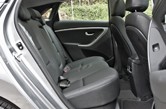 | 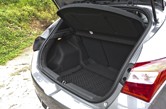 |
 |
The Drive
The driving aspect may be by far the least inspiring aspect of Hyundai cars thus far. The latest i30, however, took on changes which are confident-boosting, such as wider tracks and lower stance to improve handling.
The steering features three levels of weight adjustments. The car is a delight to pilot in city traffic or during parking manoeuvres in either 'Normal' or 'Comfort' mode. Inherently, it is under 'Sports' mode that the steering has a noticeably heavier feel. Still, it does little to prove the sporting intent, as directional changes are still bugged by numb, uninspiring feedbacks.
The re-designed underpinnings give rise to a better chassis control. Over bends the hatch retains its composure, with noticeably less body roll. The chassis too remains footed in more enthusiastic drives. Worked with a lighter foot, the hatch turns into a comfortable cruiser, and will return a respectable fuel economy figure below 8.0L/100km.
The roominess of the cabin, further accentuated by the panoramic sky-roof, helps to elevate the roomy ambience in any commute. The smooth gear transitions also made for a praise-worthy ride amidst our traffic-bound urban landscape.
The driving aspect may be by far the least inspiring aspect of Hyundai cars thus far. The latest i30, however, took on changes which are confident-boosting, such as wider tracks and lower stance to improve handling.
The steering features three levels of weight adjustments. The car is a delight to pilot in city traffic or during parking manoeuvres in either 'Normal' or 'Comfort' mode. Inherently, it is under 'Sports' mode that the steering has a noticeably heavier feel. Still, it does little to prove the sporting intent, as directional changes are still bugged by numb, uninspiring feedbacks.
The re-designed underpinnings give rise to a better chassis control. Over bends the hatch retains its composure, with noticeably less body roll. The chassis too remains footed in more enthusiastic drives. Worked with a lighter foot, the hatch turns into a comfortable cruiser, and will return a respectable fuel economy figure below 8.0L/100km.
The roominess of the cabin, further accentuated by the panoramic sky-roof, helps to elevate the roomy ambience in any commute. The smooth gear transitions also made for a praise-worthy ride amidst our traffic-bound urban landscape.
As the cog-switches are done in a more leisurely manner, they do hamper power delivery when the need to overtake arises. But bearing in mind that the carmaker was never too performance-inclined, it should not be a hinder for the family man.
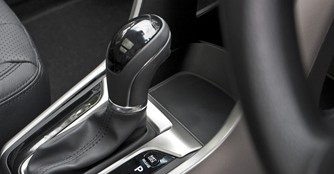
 Six-speed automatic makes for pleasant cruising, but can be slightly sluggish during overtaking manoeuvres
Six-speed automatic makes for pleasant cruising, but can be slightly sluggish during overtaking manoeuvres
Conclusion
The latest i30 has managed to stay on track for greater refinement. Combining the marque's improvement in different areas, the new hatch now liberates a greater sense of comfort.
On our local shores, the i30 is currently only available in one trim. Pre-loaded with the array of niceties, the hatchback commands a $5,000 premium over a similarly spec-ed Elantra sedan.
This may very well be the toughest bullet to bite - as we reckon the sedan is nowhere less stylish than the hatchback; yet packing more functionality with the bigger boot.

Conclusion
The latest i30 has managed to stay on track for greater refinement. Combining the marque's improvement in different areas, the new hatch now liberates a greater sense of comfort.
On our local shores, the i30 is currently only available in one trim. Pre-loaded with the array of niceties, the hatchback commands a $5,000 premium over a similarly spec-ed Elantra sedan.
This may very well be the toughest bullet to bite - as we reckon the sedan is nowhere less stylish than the hatchback; yet packing more functionality with the bigger boot.
It wasn't too long ago when each of us bore a prejudiced opinion towards automotive offerings from the Korean republic (some still do). That, mainly has got to do with their low-cost approach - we reckon what's durable can't be inexpensive too.
Over the years, however, the Korean carmakers have managed to churn out a number of eye-catching variants, which in instances made their more technically-superior rivals look dull. The i30 hatch is without a doubt one of them.
The first i30 marked a major departure for Hyundai. It was a city car which brought the carmaker's fine effort to shine. Four years now, the second iteration underwent yet another major transformation, looking all set to attract the likes of continental buyers.
Exterior
The latest hatch from Hyundai looks nothing quite like the previous. Dimension wise, the new hatch has grown in almost all aspects, most notable being the increased length (55mm) and lowered stance (down by 10mm and wider by 5mm), which gives it a more athletic look. Its front fascia (which will be the forefront of future Hyundai models), similar to the marque's recently launched Elantra and Veloster, is indeed eye-catching. Fans of the i30 are bound to love the stylish look, more so for younger drivers.
Besides the overhauled facet, body panels too, promote a more dimensional look with sharper creases running down the hood and alongside the flanks. As a result, the i30 is much more evocative among its segment contenders when it comes to styling.
Over the years, however, the Korean carmakers have managed to churn out a number of eye-catching variants, which in instances made their more technically-superior rivals look dull. The i30 hatch is without a doubt one of them.
The first i30 marked a major departure for Hyundai. It was a city car which brought the carmaker's fine effort to shine. Four years now, the second iteration underwent yet another major transformation, looking all set to attract the likes of continental buyers.
Exterior
The latest hatch from Hyundai looks nothing quite like the previous. Dimension wise, the new hatch has grown in almost all aspects, most notable being the increased length (55mm) and lowered stance (down by 10mm and wider by 5mm), which gives it a more athletic look. Its front fascia (which will be the forefront of future Hyundai models), similar to the marque's recently launched Elantra and Veloster, is indeed eye-catching. Fans of the i30 are bound to love the stylish look, more so for younger drivers.
Besides the overhauled facet, body panels too, promote a more dimensional look with sharper creases running down the hood and alongside the flanks. As a result, the i30 is much more evocative among its segment contenders when it comes to styling.
While the front facet adopts a sophisticated look with the help of chrome / matt trims and projector-style lamps, the rear shies from such integrations. In place is a simple looking reflector-type assembly. Albeit taking on a flowing shape from the side panels and bumper, the rear somehow feels less head-turning than the front.
Interior
On the inside, the i30 feels pleasantly modern despite the simplistic design of the buttons and switches. The centre console has the main role to play in exuding a contemporary feel, thanks to the twin beams finished in an attractive aluminium-look.
Hyundai's mission to move upmarket can be seen clearly from the selection of gizmo novelties. For instance, the centre rear-view mirror doubles as a reverse camera display - a clever integration that will no doubt raise the brand's quality image.
In general, there is a nice mixture of contrasting materials, with quality plastics trims decorating the steering wheel and front console, as well as out-lining the door cards. Air-con controls come in old-fashioned styled knobs, but there are no qualms about its ease of use and effectiveness in cooling down the cabin in our tropical climate.
On the inside, the i30 feels pleasantly modern despite the simplistic design of the buttons and switches. The centre console has the main role to play in exuding a contemporary feel, thanks to the twin beams finished in an attractive aluminium-look.
Hyundai's mission to move upmarket can be seen clearly from the selection of gizmo novelties. For instance, the centre rear-view mirror doubles as a reverse camera display - a clever integration that will no doubt raise the brand's quality image.
In general, there is a nice mixture of contrasting materials, with quality plastics trims decorating the steering wheel and front console, as well as out-lining the door cards. Air-con controls come in old-fashioned styled knobs, but there are no qualms about its ease of use and effectiveness in cooling down the cabin in our tropical climate.
The hatch scores well in terms of ergonomics, with buttons which are more commonly used well within reach. The audio and cruise control switches on the steering, too, makes working the equipments a breeze. That said, the i30's interior is not without shortcomings. The indicator and windscreen wiper stalks, for instance, carry a poor touch to them, feeling far-fetched from the rest of the cabin.
Space wise, rear legroom has improved significantly thanks to the increased length and better space utilisation over its predecessor. The raised centre bolstering, however, obliterates headroom for a third passenger on the rear bench, making it more suited for two in comfort. The boot packs 378 litres capacity, one of the biggest in its class, and comes with a functional floor-slung cargo net.
Space wise, rear legroom has improved significantly thanks to the increased length and better space utilisation over its predecessor. The raised centre bolstering, however, obliterates headroom for a third passenger on the rear bench, making it more suited for two in comfort. The boot packs 378 litres capacity, one of the biggest in its class, and comes with a functional floor-slung cargo net.
The Drive
The driving aspect may be by far the least inspiring aspect of Hyundai cars thus far. The latest i30, however, took on changes which are confident-boosting, such as wider tracks and lower stance to improve handling.
The steering features three levels of weight adjustments. The car is a delight to pilot in city traffic or during parking manoeuvres in either 'Normal' or 'Comfort' mode. Inherently, it is under 'Sports' mode that the steering has a noticeably heavier feel. Still, it does little to prove the sporting intent, as directional changes are still bugged by numb, uninspiring feedbacks.
The re-designed underpinnings give rise to a better chassis control. Over bends the hatch retains its composure, with noticeably less body roll. The chassis too remains footed in more enthusiastic drives. Worked with a lighter foot, the hatch turns into a comfortable cruiser, and will return a respectable fuel economy figure below 8.0L/100km.
The roominess of the cabin, further accentuated by the panoramic sky-roof, helps to elevate the roomy ambience in any commute. The smooth gear transitions also made for a praise-worthy ride amidst our traffic-bound urban landscape.
The driving aspect may be by far the least inspiring aspect of Hyundai cars thus far. The latest i30, however, took on changes which are confident-boosting, such as wider tracks and lower stance to improve handling.
The steering features three levels of weight adjustments. The car is a delight to pilot in city traffic or during parking manoeuvres in either 'Normal' or 'Comfort' mode. Inherently, it is under 'Sports' mode that the steering has a noticeably heavier feel. Still, it does little to prove the sporting intent, as directional changes are still bugged by numb, uninspiring feedbacks.
The re-designed underpinnings give rise to a better chassis control. Over bends the hatch retains its composure, with noticeably less body roll. The chassis too remains footed in more enthusiastic drives. Worked with a lighter foot, the hatch turns into a comfortable cruiser, and will return a respectable fuel economy figure below 8.0L/100km.
The roominess of the cabin, further accentuated by the panoramic sky-roof, helps to elevate the roomy ambience in any commute. The smooth gear transitions also made for a praise-worthy ride amidst our traffic-bound urban landscape.
As the cog-switches are done in a more leisurely manner, they do hamper power delivery when the need to overtake arises. But bearing in mind that the carmaker was never too performance-inclined, it should not be a hinder for the family man.
Conclusion
The latest i30 has managed to stay on track for greater refinement. Combining the marque's improvement in different areas, the new hatch now liberates a greater sense of comfort.
On our local shores, the i30 is currently only available in one trim. Pre-loaded with the array of niceties, the hatchback commands a $5,000 premium over a similarly spec-ed Elantra sedan.
This may very well be the toughest bullet to bite - as we reckon the sedan is nowhere less stylish than the hatchback; yet packing more functionality with the bigger boot.
Conclusion
The latest i30 has managed to stay on track for greater refinement. Combining the marque's improvement in different areas, the new hatch now liberates a greater sense of comfort.
On our local shores, the i30 is currently only available in one trim. Pre-loaded with the array of niceties, the hatchback commands a $5,000 premium over a similarly spec-ed Elantra sedan.
This may very well be the toughest bullet to bite - as we reckon the sedan is nowhere less stylish than the hatchback; yet packing more functionality with the bigger boot.
Also read our comparison article on:
Hyundai i30 1.6 (A) Toyota Auris 1.6 (A) vs Volkswagen Golf 1.4 TSI DSG (A)Car Information
Hyundai i30 1.6 (A)
CAT B|Petrol|14.7km/L
Horsepower
97kW (130 bhp)
Torque
157 Nm
Acceleration
-
This model is no longer being sold by local distributor
All Used Hyundai i30Thank You For Your Subscription.

























